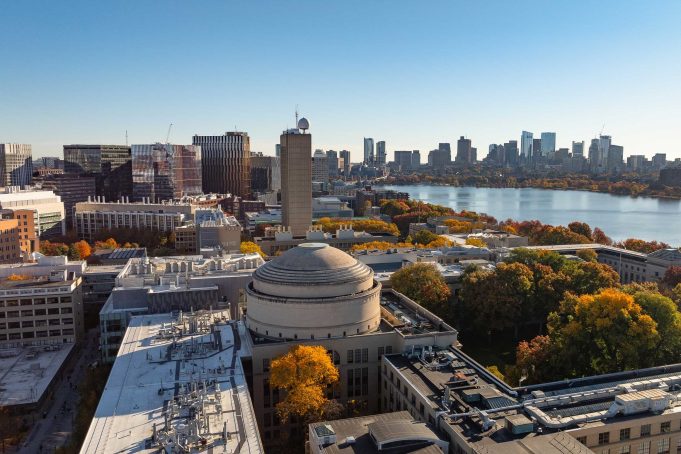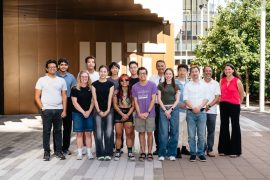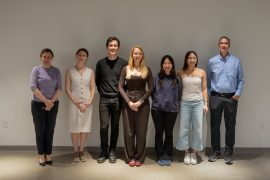Helping students bring about decarbonization, from benchtop to global energy marketplace

Professor Jessika Trancik’s course helps students understand energy levers for addressing climate change at the macro and micro scales.
MIT students are adept at producing research and innovations at the cutting edge of their fields. But addressing a problem as large as climate change requires understanding the world’s energy landscape, as well as the ways energy technologies evolve over time.
Since 2010, the course IDS.521/IDS.065 (Energy Systems for Climate Change Mitigation) has equipped students with the skills they need to evaluate the various energy decarbonization pathways available to the world. The work is designed to help them maximize their impact on the world’s emissions by making better decisions along their respective career paths.
“The question guiding my teaching and research is how do we solve big societal challenges with technology, and how can we be more deliberate in developing and supporting technologies to get us there?” says Professor Jessika Trancik, who started the course to help fill a gap in knowledge about the ways technologies evolve and scale over time.
Since its inception in 2010, the course has attracted graduate students from across MIT’s five schools. The course has also recently opened to undergraduate students and been adapted to an online course for professionals.
Class sessions alternate between lectures and student discussions that lead up to semester-long projects in which groups of students explore specific strategies and technologies for reducing global emissions. This year’s projects span several topics, including how quickly transmission infrastructure is expanding, the relationship between carbon emissions and human development, and how to decarbonize the production of key chemicals.
The curriculum is designed to help students identify the most promising ways to mitigate climate change whether they plan to be scientists, engineers, policymakers, investors, urban planners, or just more informed citizens.
“We’re coming at this issue from both sides,” explains Trancik, who is part of MIT’s Institute for Data, Systems, and Society. “Engineers are used to designing a technology to work as well as possible here and now, but not always thinking over a longer time horizon about a technology evolving and succeeding in the global marketplace. On the flip side, for students at the macro level, often studies in policy and economics of technological change don’t fully account for the physical and engineering constraints of rates of improvement. But all of that information allows you to make better decisions.”
Bridging the gap
As a young researcher working on low-carbon polymers and electrode materials for solar cells, Trancik always wondered how the materials she worked on would scale in the real world. They might achieve promising performance benchmarks in the lab, but would they actually make a difference in mitigating climate change? Later, she began focusing increasingly on developing methods for predicting how technologies might evolve.
“I’ve always been interested in both the macro and the micro, or even nano, scales,” Trancik says. “I wanted to know how to bridge these new technologies we’re working on with the big picture of where we want to go.”
Trancik’ described her technology-grounded approach to decarbonization in a paper that formed the basis for IDS.065. In the paper, she presented a way to evaluate energy technologies against climate-change mitigation goals while focusing on the technology’s evolution.
“That was a departure from previous approaches, which said, given these technologies with fixed characteristics and assumptions about their rates of change, how do I choose the best combination?” Trancik explains. “Instead we asked: Given a goal, how do we develop the best technologies to meet that goal? That inverts the problem in a way that’s useful to engineers developing these technologies, but also to policymakers and investors that want to use the evolution of technologies as a tool for achieving their objectives.”
This past semester, the class took place every Tuesday and Thursday in a classroom on the first floor of the Stata Center. Students regularly led discussions where they reflected on the week’s readings and offered their own insights.
“Students always share their takeaways and get to ask open questions of the class,” says Megan Herrington, a PhD candidate in the Department of Chemical Engineering. “It helps you understand the readings on a deeper level because people with different backgrounds get to share their perspectives on the same questions and problems. Everybody comes to class with their own lens, and the class is set up to highlight those differences.”
The semester begins with an overview of climate science, the origins of emissions reductions goals, and technology’s role in achieving those goals. Students then learn how to evaluate technologies against decarbonization goals.
But technologies aren’t static, and neither is the world. Later lessons help students account for the change of technologies over time, identifying the mechanisms for that change and even forecasting rates of change.
Students also learn about the role of government policy. This year, Trancik shared her experience traveling to the COP29 United Nations Climate Change Conference.
“It’s not just about technology,” Trancik says. “It’s also about the behaviors that we engage in and the choices we make. But technology plays a major role in determining what set of choices we can make.”
From the classroom to the world
Students in the class say it has given them a new perspective on climate change mitigation.
“I have really enjoyed getting to see beyond the research people are doing at the benchtop,” says Herrington. “It’s interesting to see how certain materials or technologies that aren’t scalable yet may fit into a larger transformation in energy delivery and consumption. It’s also been interesting to pull back the curtain on energy systems analysis to understand where the metrics we cite in energy-related research originate from, and to anticipate trajectories of emerging technologies.”
Onur Talu, a first-year master’s student in the Technology and Policy Program, says the class has made him more hopeful.
“I came into this fairly pessimistic about the climate,” says Talu, who has worked for clean technology startups in the past. “This class has taught me different ways to look at the problem of climate change mitigation and developing renewable technologies. It’s also helped put into perspective how much we’ve accomplished so far.”
Several student projects from the class over the years have been developed into papers published in peer-reviewed journals. They have also been turned into tools, like carboncounter.com, which plots the emissions and costs of cars and has been featured in The New York Times.
Former class students have also launched startups; Joel Jean SM ’13, PhD ’17, for example, started Swift Solar. Others have drawn on the course material to develop impactful careers in government and academia, such as Patrick Brown PhD ’16 at the National Renewable Energy Laboratory and Leah Stokes SM ’15, PhD ’15 at the University of California at Santa Barbara.
Overall, students say the course helps them take a more informed approach to applying their skills toward addressing climate change.
“It’s not enough to just know how bad climate change could be,” says Yu Tong, a first-year master’s student in civil and environmental engineering. “It’s also important to understand how technology can work to mitigate climate change from both a technological and market perspective. It’s about employing technology to solve these issues rather than just working in a vacuum.”


